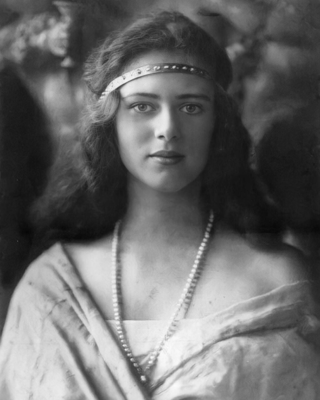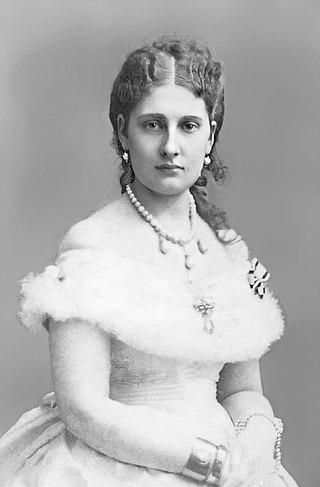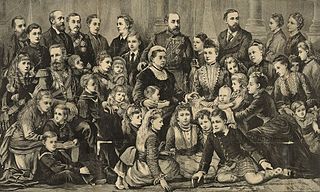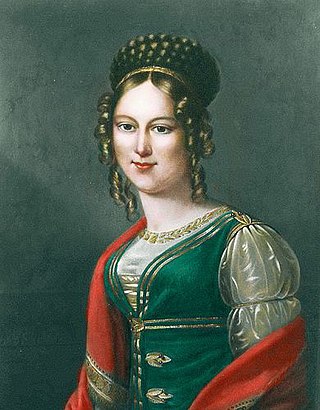
Ferdinand I, nicknamed Întregitorul, was King of Romania from 1914 until his death in 1927. Ferdinand was the second son of Leopold, Prince of Hohenzollern, and Infanta Antónia of Portugal, daughter of Ferdinand II of Portugal and Maria II of Portugal. His family was part of the Catholic branch of the Prussian royal family Hohenzollern.

Maria, known in Serbian as Marija Karađorđević, was Queen of the Serbs, Croats and Slovenes from 1922 to 1929 and Queen of Yugoslavia from 1929 to 1934 as the wife of King Alexander I. She was the mother of King Peter II. Her citizenship was revoked, and her property was confiscated by the Yugoslav communist regime in 1947, but she was posthumously rehabilitated in 2014.

Alexander, Crown Prince of Yugoslavia, is the head of the House of Karađorđević, the former royal house of the defunct Kingdom of Yugoslavia and its predecessor the Kingdom of Serbia. Alexander is the only child of King Peter II and his wife, Princess Alexandra of Greece and Denmark. He held the position of crown prince in the Democratic Federal Yugoslavia for the first four-and-a-half months of his life, until the declaration of the Federal People's Republic of Yugoslavia later in November 1945, when the monarchy was abolished. In public he claims the crowned royal title of "Alexander II Karadjordjevic" as a pretender to the throne.

Marie was the last queen of Romania as the wife of King Ferdinand I.

Elisabeth Charlotte Josephine Alexandra Victoria of Romania was the second child and eldest daughter of King Ferdinand I and Queen Marie of Romania. She was Queen of Greece from 27 September 1922 until 25 March 1924 as the wife of King George II.

Princess Ileana of Romania, also known as Mother Alexandra, was the youngest daughter of King Ferdinand I of Romania and his consort, Queen Marie of Romania. She was a great-granddaughter of Emperor Alexander II of Russia, King Ferdinand II, Queen Maria II of Portugal, and Queen Victoria of the United Kingdom. She was born as Her Royal Highness Princess Ileana of Romania, Princess of Hohenzollern-Sigmaringen.
Prince Tomislav of Yugoslavia was a member of the House of Karađorđević, the second son of King Alexander I and Queen Maria of Yugoslavia. He was a younger brother of King Peter II of Yugoslavia and a former nephew-in-law to Queen Elizabeth II and Prince Philip.

Anne was the wife of King Michael I of Romania. She married Michael in 1948, the year after he had abdicated the throne. Nonetheless, she was known after the marriage as Queen Anne.

The House of Leszczyński was a prominent Polish noble family. They were magnates in the Polish–Lithuanian Commonwealth and later became royal family of Poland.

Princess Elizabeth of Greece and Denmark was the middle daughter of Prince Nicholas of Greece and Grand Duchess Elena Vladimirovna of Russia.

Infanta Antónia of Portugal was a Portuguese infanta (princess) of the House of Braganza, daughter of Queen Maria II of Portugal and her King consort Ferdinand II of Portugal. Through her father, she also held the titles of Princess of Saxe-Coburg and Gotha and Duchess of Saxony.

Prince Andrew of Yugoslavia was the youngest child of King Alexander I of Yugoslavia and Maria of Yugoslavia.

The Romanian royal family was the ruling dynasty of the Kingdom of Romania, a constitutional monarchy in Central-Eastern Europe. The kingdom existed from 1881, when Carol I of Romania was proclaimed king, until 1947, when the last king, Michael I of Romania, was forced to abdicate and the Parliament proclaimed Romania a republic. Soon after, upon the establishment of the constitution of 13 April 1948, Romania became a people's republic, a state that lasted until 1989.
Princess Maria may refer to:

Queen Victoria, the British monarch from 1837 to 1901, and Prince Albert had 9 children, 42 grandchildren, and 87 great-grandchildren. Victoria was called the "grandmother of Europe".

Princess Mária Antónia Gabriella Koháry de Csábrág et Szitnya was a Hungarian noblewoman and the ancestor of several European monarchs. She was the sole heiress of the House of Koháry, which belonged to one of the three largest landowners in Hungary.

The Order of Carol I was the highest ranking of the Romanian honours of the Kingdom of Romania until the founding of the Order of Michael the Brave in 1916 by King Ferdinand I of Romania. It was instituted on 10 May 1906 by King Carol I to celebrate the Ruby Jubilee of 40 years of his reign.

The Pantheon of the House of Braganza, also known as the Pantheon of the Braganzas, is the final resting place for many of the members of the House of Braganza, located in the Monastery of São Vicente de Fora in the Alfama district of Lisbon, Portugal. The pantheon's burials have included Portuguese monarchs, Brazilian monarchs, a Romanian monarch, queen consorts of Portugal, and notable Infantes of Portugal, among others.

Princess Katarina of Yugoslavia, Lady de Silva is an English businessperson specialising in etiquette and decorum courses. She is a member of the extended former Yugoslavian royal family.
The 1922 King Alexander's Cup was the first edition of the Friendship Cup. It was a single-game tournament in 1922 and the first official match of the national association football team of Romania.
















